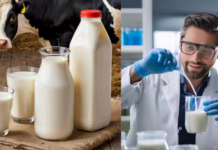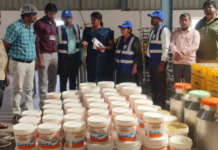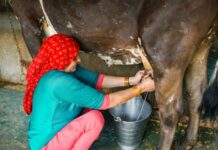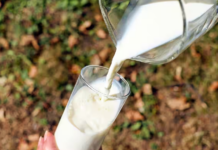Indian dairy industry today
Indian industry has a face of panoramic portfolio in terms of products and processes. The shift in consumer behaviour from spoon to slurp has revolutionised the band wagon of plush liquid products category. The never ending want of us to shift from tasty to heart-friendly nourishment somehow backs us as serotonin does compromise on nutrients alone, compelling dairy industry to strike a balance between health and taste. India proudly stands as the world’s largest milk producer, producing 16% of the world’s milk. It has been enjoying a minimum growth rate of 4% consistently. This has also increased the per capita milk consumption to 305 g per day (ICMR).
Milks and milk products have been important human food items for centuries. Milks are mostly obtained from buffaloes, cows, goats, sheep and lately camel in India. Milk is mainly an essential food during infancy. Milk is highly nutritious and is one of the few foods that can sustain a young one (both animals and humans) without supplementation. Being nutritious in nature, it also serves as an excellent medium for growth of micro-organisms. The procured milk is made safe by subjecting it to various unit operations of processing ranging anywhere from thermisation, pasteurisation, ultrahigh temperature to sterilisation.
The common liquid milk products available in the Indian market are pasteurised milk, UHT milk, cream, cultured milks, condensed milk, flavoured milk, smoothies, liquid yoghurt; however, the trend of reverse urbanisation does not exempt dairy too, hence traditional products are also gripping the market with advent of convenient products like basundi, kheer, and lassi.
The products available in India have compulsory regulations in existing laws such as FSS Act, 2006, which provides for processing and marketing standards that were ignored previously due to multiplicity of food laws. These constraints of law enforcement are covered under the umbrella of FSSA. The fact that some standards may not be practical from the point of view of market agents and consumers is not considered.
There are groups and associations that have organised themselves to influence the supply and demand of the dairy industry and this is the cooperative sector that undoubtedly handles all the ethical dairying. Organised groups influence standards as well as market conditions in terms of supply and demand for the products. However the milk and dairy products market in India has been liberalised since the early 1992, post-MMPO Act, 1992, whereby the price of both raw milk and its products are determined by market forces to a larger extent. This has led to free participation of the private sector and also increased informal marketing standards and regulations for dairy products. Unlike other regions, the Western part of India has sustained the cooperative movement; this has led to the formation of the cooperative unions with a membership of many district unions, primary societies, and 3.6 million dairy farmers.
The concept of milk quality refers to a combination of characteristics that enhance the acceptability of the milk product. Quality relates to chemical, physical, technological, bacteriological and aesthetic characteristics of milk and milk products. Milk safety refers to a condition in which the risk of milk to harm and damage is limited to an acceptable level. The nutritious nature of milk serves as an excellent medium for growth of micro-organisms. Some of these micro-organisms cause illness to humans and others cause spoilage in milk rendering it unfit (unsafe) for consumption.
Basic milk microbiology
Milk is virtually sterile when synthesised in a healthy cow. Cows, like humans, are natural reservoirs of bacteria, many of which are not harmful to humans, but some may be harmful to humans even though the cows are not affected and appear healthy. Milk may become contaminated with bacteria during or after milking. Contamination may occur in cases when the disease-causing organisms (pathogens) are shed through cow faeces contaminating the outside of the udder and teats, the farm environment (e.g. bedding) and the milking equipment.
Although optimal growth conditions for bacteria are different for different organisms, milk contains important nutritional components for mammal growth, and, therefore, it is also an ideal medium for the growth of different bacteria. Temperature plays an important role in bacterial growth. Many bacteria prefer to grow at body temperature (86-98°F, 30- 37°C), but will grow at lower temperatures (such as refrigerator temperature) at slower rates. The extent of the contamination that takes place, depends upon the hygienic measures taken before, during and after the milking process and storage. Therefore, it is essential to control these micro-organisms.
Milk safety and quality assurance has become an area of priority and necessity for consumers, retailers, manufacturers and regulators. Changing global patterns of food production, international trade and public expectations for health protection have created a huge demand for food safety. Globalisation of economy and trade has brought integration of domestic markets with the world economy and increasingly stringent food safety and quality standards. With the globalisation in the dairy industry shift in milk production strategies is necessary to ensure quality milk production. The quality of raw milk has a direct impact on the quality of product prepared from it.
Steps to Assure Safe Quality of Milk
• Promotion of chilling centres in consonance with the rise in production of milk
• Private participation to be encouraged by providing infrastructure such as land and interest-free loans
• In rural areas, propagating the identified village practices for enhancement of quality in outreach villages
• Village level quality assurance and control through strengthening of existing laboratories
• Establishment of certification laboratories
• Awareness capacity building
• Premium pricing policy. For a proper milk value chain, a systematic approach to quality care is needed, focussing on each individual link in the production chain. Every participant in the dairy supply chain must be responsible in developing this quality system.
Dairy technology offers promising options for value addition and resource recovery in terms of consumer food availability and simultaneously improved income-generation for farmers and industry level. There is large scope for the milk industry to grow in view of the globalisation and increasing purchasing power of consumers.
Quality Assurance and Certification Schemes (QAS) can generally be defined as any code of practice, standard or set of requisites, which enables stakeholders of the food supply chain to guarantee compliance. QAS are schemes implying a voluntary participation and enabling stakeholders involved in the food chain to claim that products or processes fulfil defined quality requirements. QAS objectives are to (1) Standardise and guarantee certain aspects or requirements of the company or production unit (QAS belonging to the family of ISO, BRC, IFS, etc.); QAS belonging to the first group are set up by ISO or by retailer consortia and are always multinational in scope (they are disseminated over several countries). Finally, they tend to certify compliance to legal requirements (rarely) or requirements that go beyond the law (more often) and are almost exclusively adopted in B2B (i.e. not used in communication campaigns for the user).
Contemporary ‘from-farm-to-table’ approaches in dairy planning and management
In India, milk production is confined to rural areas and the demand is mostly urban in nature. Hence the milk has to be collected and transported from the production points in the milk shed areas to processing and distribution points in city/towns. The infrastructure for the rural milk collection is not well developed in most parts of the country except the western region and to a lesser extent the northern central region. The eastern and northern regions lack functional rural milk collection centres with cooling equipment.
Water for dairy
Water dairy processing establishments should have potable water available, which prior to its first use, should meet the criteria specified by the competent authorities having jurisdiction and should be regularly monitored. Water recirculated for reuse should be treated and maintained in such a condition that no risk to the safety and suitability of food results from its use. Proper maintenance of water conditioning systems is critical to avoid the systems becoming sources of contamination. For example, filter systems can become sources of bacteria and their metabolites if bacteria are allowed to grow on the organic materials that have accumulated on the filter.
Appropriate safety and suitability criteria that meet the intended outcomes should be established for any water used in dairy processing. These criteria depend upon the origin and the intended use of the water. For example, reuse water intended for incorporation into a food product should at least meet the microbiological specifications for potable water.
Reconditioning of water for reuse and use of reclaimed, recirculated and recycled water should be managed in accordance with HACCP principles. Any reuse of water should be subject to a hazard analysis including assessment of whether it is appropriate for reconditioning. Critical control point(s) should be identified, as appropriate, and critical limit(s) established and monitored to verify compliance.
Establishment: Maintenance and sanitation
Maintenance and cleaning processing areas should be kept as dry as possible. Use of dry cleaning methods, and limiting the use of water in processing areas, helps to avoid the spread of contamination by water. Wet cleaning (other than cleaning-in-place) has been known to lead to milk product contamination due to the production of aerosols.
All food product contact surfaces in piping and equipment, including areas that are difficult to clean such as by-pass valves, sampling valves, and overflow siphons in fillers should be adequately cleaned.
Training
Training programmes have their own importance in assuring safety; it should for milk producers and personnel involved in the collection and transport and retail of milk should be trained as necessary and have appropriate skills in the areas listed below:
Health of animals and use of veterinary drugs; Manufacturing and use of feeds (more specifically fermented feeds); Herd management; hygienic milking; storage, handling, collection and transport of milk (cleaning of storage tanks, temperature requirements, sampling procedures, etc.); Microbiological, chemical and physical hazards and their control measures.
Key technology developments:
With the advent of the new technologies, the dairy sector would be able to add more value to the milk and milk products. Some of the dairy related technologies and the potential they bring in are highlighted below:
• Ultra High Temperature (UHT) processing and aseptic packaging: This technology has transformed dairy industry as it involves producing dairy products with longer shelf life by sterilising the product. As people become more and more health-conscious, UHT milk has gained popularity as it is safe, convenient and has a longer shelf life. Although in terms of percentage, UHT milk occupies a very small share in the dairy segment; it is growing at a rapid rate.
• Scraped surface heat exchangers and higher pasteurisation: With this technology along with higher pasteurisation and modernised mechanical systems, the Indian dairy industry can manufacture traditional sweets and cater to the ever increasing demand from the export markets of the US and UK, and South Asian and African countries.
• Membrane processing: This technology is gaining importance over conventional processes for its advantages and also new possibilities of producing newer intermediate dairy products.
• New whey products
Key opportunities
• The last few decades witnessed significant increase in per capita availability of milk. While it is the highest in Asia region, it is still lower than the global availability
• In order to keep pace with the demand for milk of the rising population, production has to increase at the rate of 5.5% to 180 million tonne by 2020. If that does not happen, India will have to import milk
• Huge demand of milk and milk products is being catered by unorganised retail, so there is potential for organised players to expand
• Large dairies are feeling the need to invest in backward integration and also looking for developing large herd farms
• While new markets from South East Asia, Far East and North Africa are opening up for the Indian exporters, exports are not rising as the domestic market is absorbing the production and also due to ban on export of milk powder imposed by government to control inflation
• Considering the higher purchasing power, higher awareness and preference for tertiary processed milk products coupled with low availability, there is an opportunity to grow the spending on this category
Conclusion
The authorities are required to continuously monitor the quality of products and production processes to ensure compliance with applicable rules and regulations. Adoption of the latest and advanced dairy and value addition technology in milk processing can minimise losses; provide better quality, nutrition and more employment opportunities. Change in consumption pattern, which is driven by quality (freshness of product), variety (range of products) and convenience (access to product), posing further challenges like ambiguity in food laws also possess cardinal threats. Although the responsibility lies with the manufacturer for ensuring that the foods manufactured are safe and suitable, there is a continuum of effective effort or controls needed by other parties, including milk producers, to assure the safety and suitability of milk products. It is important to recognise that distributors, competent authorities and consumers also have a role in ensuring the safety and suitability of milk and milk products.
Although the responsibility lies with the manufacturer for ensuring that the foods manufactured are safe and suitable, there is a continuum of effective effort or controls needed by other parties, including milk producers, to assure the safety and suitability of milk products. It is important to recognise that distributors, competent authorities and consumers also have a role in ensuring the safety and suitability of milk and milk products.
References
• IBEF report on food processing industry – June 2014
• Food Processing Industry report by CII-Factor
• Netscribes report on Dairy Market in India, 2014
• Report on food processing and technology by J Food Process Technol, 2013
• Ministry of Food Processing Industries, India – Databank 2012-13
• Ministry of Food Processing Industries, India – Annual Report 2011-12
• National Restaurant Association of India (NRAI) report
• WWF India Report on “Global Practices in promoting environmental sustainability” in 2014
• CARE ratings analysis of GDP – FY14(MOSPI)
• Grant Thornton Report on Global Industry Trend analysis, Food and Beverages sources:
• European Food Information Council
• The Guardian
• Heart and Stroke Foundation South Africa Press Release
• Euromonitor International
• “Organic Foods & Beverages Market Analysis And Segment Forecasts To 2020”, Grand View Research
• Linklaters Emerging Opportunities Index.
































